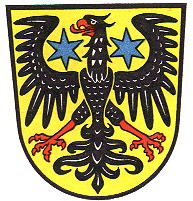Grävenwiesbach: Difference between revisions
Knorrepoes (talk | contribs) No edit summary |
Knorrepoes (talk | contribs) m (Text replace - "[[Literature" to "{{media}} [[Literature") |
||
| Line 23: | Line 23: | ||
The eagle is the Imperial eagle and indicates that the village historically was a free Imperial Estate. The origin of the stars is not known. The blue colour was chosen in 1952 as it is the colour of [[Nassau]], to which the village belonged for many centuries. | The eagle is the Imperial eagle and indicates that the village historically was a free Imperial Estate. The origin of the stars is not known. The blue colour was chosen in 1952 as it is the colour of [[Nassau]], to which the village belonged for many centuries. | ||
{{media}} | |||
[[Literature]] : Stadler, K. : Deutsche Wappen - Bundesrepublik Deutschland. Angelsachsen Verlag, 1964-1971, 8 volumes. | [[Literature]] : Stadler, K. : Deutsche Wappen - Bundesrepublik Deutschland. Angelsachsen Verlag, 1964-1971, 8 volumes. | ||
Revision as of 22:17, 8 July 2014
| Heraldry of the World Civic heraldry of Germany - Deutsche Wappen (Gemeindewappen/Kreiswappen) |
GRÄVENWIESBACH
State : Hessen
District (Kreis) : Hochtaunuskreis (until 1975 Usingen)
Additions : 1972 Heinzenberg, Hundstadt, Laubach, Mönstadt, Naunstadt
Official blazon
Origin/meaning
The oldest known seal of the town, known from 1534, but dating from the 15th century, already shows the eagle and stars.
All later images and seals have shown the same composition, which was officially granted in 1952.
The eagle is the Imperial eagle and indicates that the village historically was a free Imperial Estate. The origin of the stars is not known. The blue colour was chosen in 1952 as it is the colour of Nassau, to which the village belonged for many centuries.
Contact and Support
Partners:
Your logo here ?
Contact us
© since 1995, Heraldry of the World, Ralf Hartemink 
Index of the site
Literature : Stadler, K. : Deutsche Wappen - Bundesrepublik Deutschland. Angelsachsen Verlag, 1964-1971, 8 volumes.











